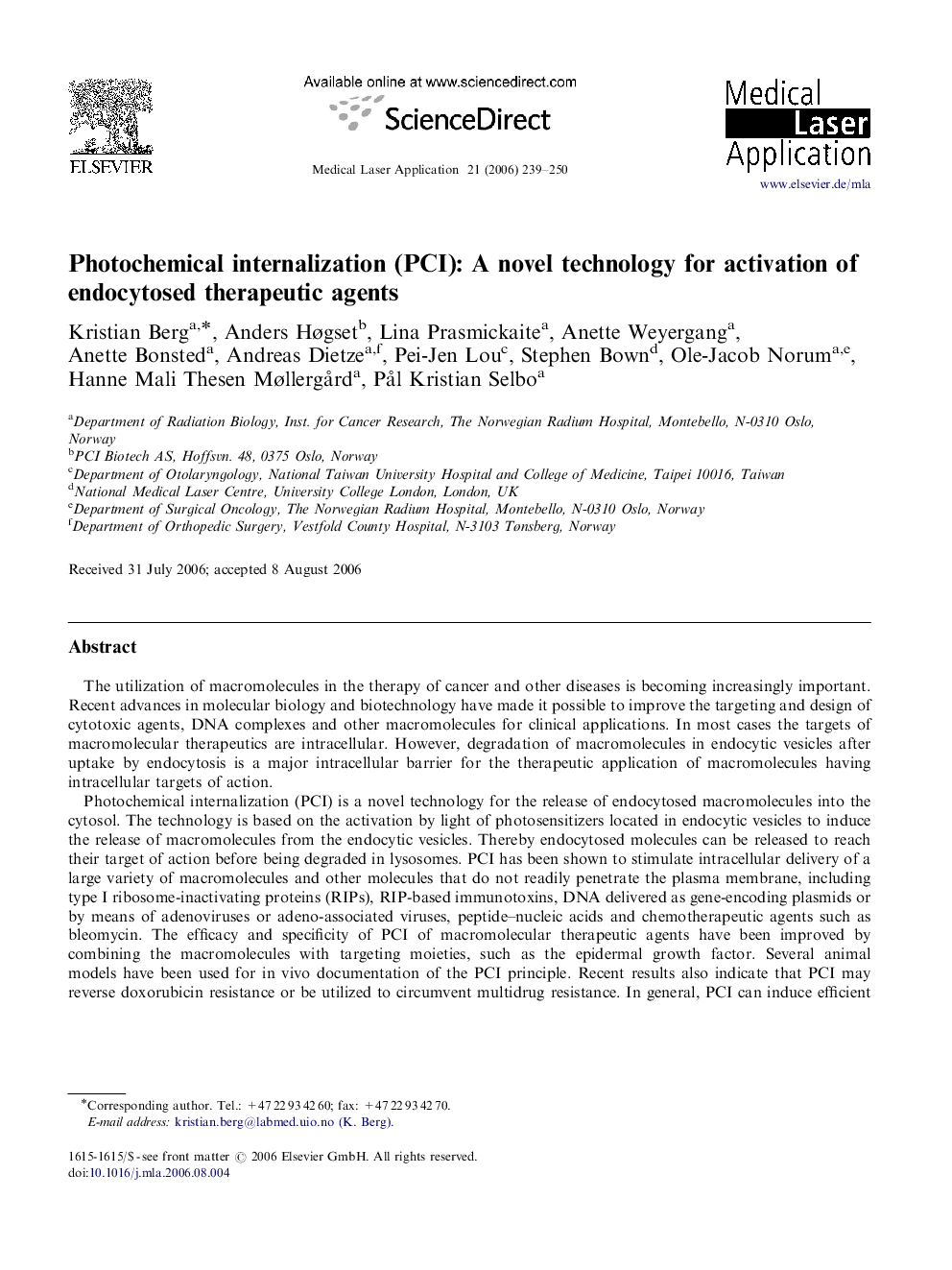| کد مقاله | کد نشریه | سال انتشار | مقاله انگلیسی | نسخه تمام متن |
|---|---|---|---|---|
| 2068470 | 1544395 | 2006 | 12 صفحه PDF | دانلود رایگان |

The utilization of macromolecules in the therapy of cancer and other diseases is becoming increasingly important. Recent advances in molecular biology and biotechnology have made it possible to improve the targeting and design of cytotoxic agents, DNA complexes and other macromolecules for clinical applications. In most cases the targets of macromolecular therapeutics are intracellular. However, degradation of macromolecules in endocytic vesicles after uptake by endocytosis is a major intracellular barrier for the therapeutic application of macromolecules having intracellular targets of action.Photochemical internalization (PCI) is a novel technology for the release of endocytosed macromolecules into the cytosol. The technology is based on the activation by light of photosensitizers located in endocytic vesicles to induce the release of macromolecules from the endocytic vesicles. Thereby endocytosed molecules can be released to reach their target of action before being degraded in lysosomes. PCI has been shown to stimulate intracellular delivery of a large variety of macromolecules and other molecules that do not readily penetrate the plasma membrane, including type I ribosome-inactivating proteins (RIPs), RIP-based immunotoxins, DNA delivered as gene-encoding plasmids or by means of adenoviruses or adeno-associated viruses, peptide–nucleic acids and chemotherapeutic agents such as bleomycin. The efficacy and specificity of PCI of macromolecular therapeutic agents have been improved by combining the macromolecules with targeting moieties, such as the epidermal growth factor. Several animal models have been used for in vivo documentation of the PCI principle. Recent results also indicate that PCI may reverse doxorubicin resistance or be utilized to circumvent multidrug resistance. In general, PCI can induce efficient light-directed delivery of macromolecules into the cytosol, indicating that it may have a variety of useful applications for site-specific drug delivery, as for example in gene therapy, vaccination and cancer treatment.
ZusammenfassungDie Nutzung von Makromolekülen bei der Therapie von Tumoren und anderen Krankheiten gewinnt immer mehr an Bedeutung. Fortschritte in der Molekularbiologie und Biotechnologie haben es ermöglicht, den gezielten Einsatz und die Entwicklung von zytotoxischen Substanzen, DNA-Komplexen und anderen Makromolekülen für klinische Anwendungen zu verbessern. In den meisten Fällen sind die Ziele der Makromoleküle intrazellulärer Natur. Der Abbau von Makromolekülen in endozytotischen Vesikeln nach Endozytose stellt jedoch ein beträchtliches Problem für die therapeutische Anwendung von Makromolekülen mit intrazellulärer Wirkung dar.Die photochemische Internalisierung (PCI) ist eine neue Technologie zur Freisetzung von Makromolekülen ins Zytosol, die über Endozytose aufgenommen wurden. Das Verfahren beruht auf der Lichtaktivierung von Photosensibilisatoren in endozytotischen Vesikeln. Auf diese Weise soll die Freisetzung von Makromolekülen aus den endozytotischen Vesikeln induziert werden. Dadurch können diese ihr Ziel erreichen, ehe sie in Lysosomen abgebaut werden. Es hat sich erwiesen, dass PCI den intrazellulären Transport einer Vielzahl von Makro- und anderen Molekülen stimuliert, die die Plasmamemban sonst schwer durchdringen. Dazu gehören Ribosomen inaktivierende Proteine (RIPs) vom Typ I, RIP-basierte Immunotoxine, genkodierende Plasmide, Adenoviren oder Adenoviren nahestehende Viren, Peptid-Nucleinsäuren sowie chemotherapeutische Substanzen wie Bleomycin. Die Effizienz und Spezifität der PCI makromolekularer Therapeutika kann noch verbessert werden, indem man die Makromoleküle mit Antikörpern, z.B. dem epidermalen Wachstumsfaktor, kombiniert. Zur In-vivo-Dokumentation des PCI-Prinzips wurden verschiedene Tiermodelle verwendet. Neuere Ergebnisse deuten auch darauf hin, dass die PCI die Doxorubicinresistenz umkehren kann und generell gegen die multiple Medikamentenresistenz genutzt werden könnte. Zusammenfassend ist die PCI ein Verfahren, das nutzbringend beim gezielten Medikamententransport, z.B. in der Gentherapie, bei Impfungen und in der Tumortherapie eingesetzt werden kann.
ResúmenLa utilización de macromoléculas en el tratamiento del cáncer y otras enfermedades ha cobrado gran importancia. Los adelantos en el campo de la biología molecular y la biotecnología han permitido una mejora en el diseño de agentes citotóxicos, complejos de ADN y otras macromoléculas para su uso clínico. En la mayoría de los casos, el blanco de la terapia macromolecular es intracelular. Sin embargo, la degradación en vesículas endocíticas es una barrera intracelular importante para el uso terapéutico de este tipo de macromoléculas.La internalización fotoquímica (PCI) es una nueva tecnología, basada en la activación por luz de fotosensibilizadores localizados en vesiculas endocíticas, que facilita la liberación en el citosol de las macromoléculas endocitadas. De este modo, las moléculas endocitadas pueden ser liberadas para alcanzar su blanco de acción antes de ser degradadas en los lisosomas. La PCI ha sido utilizada para inducir la liberación de una gran variedad de macromoléculas o de moléculas que no son capaces de penetrar la membrana plasmática, incluyendo proteínas inactivantes de ribosomas (RIPs) tipo I, inmunotoxinas basadas en RIP, ADN liberado mediante plásmidos, o por medio de adenovirus, virus adeno-asociados, ácidos nucleicos peptídicos o agentes quimioterapéuticos como la bleomicina. La eficiencia y la especificidad de la PCI de agentes terapéuticos macromoleculares ha sido perfeccionada combinando estas macromoléculas con blancos específicos, tales como el Factor de Crecimiento Epidérmico. Varios modelos animales han sido utilizados para la documentación in vivo del principio de la PCI. Más aún, resultados recientes indican que la PCI podría revertir la resistencia a la doxorubicina o ser utilizada para prevenir la resistencia multidroga. En general, dado que permite la liberación eficiente de macromoléculas en el citosol, la internalización fotoquímica podría ser utilizada en una gran variedad de aplicaciones en donde se requiere la liberación sitio-específica de la droga, como en terapia génica, vacunación o en el tratamiento del cáncer.
Journal: Medical Laser Application - Volume 21, Issue 4, 15 November 2006, Pages 239–250